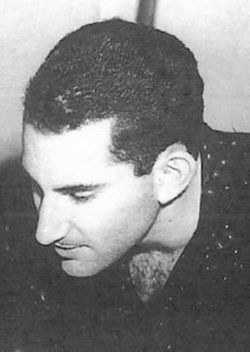Eugene Dinkin
( spook, whistleblower) | |
|---|---|
 | |
| Born | 10 Jun 1938 |
| Died | 21 May 2012 (Age 73) |
| Nationality | US |
| Exposed | |
AN "unsung hero" spook who intercepted a communication about the JFK assassination. Shared this with journalists in the press room of the United Nations office in Geneva. Smeared as having poor mental health | |
Eugene B. Dinkin was a cryptographic code operator stationed in Metz, France in Autumn of 1963 when he deciphered messages concerning the upcoming assassination of JFK. When he tried to share this information he was locked up in a psychiatric ward (as was David Christensen).
Contents
JFK Assassination
- Full article: JFK Assassination
- Full article: JFK Assassination
Three weeks before the assassination, Private First Class Dinkin was station in Metz, France. He intercepted and decoded two messages concerning a planned assassination of JFK, one in mid October, one on 2nd November 1963.[1] The messages contained three names connected to the assassination conspiracy: William Harvey, Jean Souetre, and Guy Banister.[2] Harvey was then stationed in Rome, Italy. Long-time CIA operative Gerry Patrick Hemming, through his association with Cuban exile groups, was privy to rumors of a super-secret assassination team based in the Florida Keys under ultimate direction from William Harvey. Jean Souetre was a French paramilitary operative with the French security service SDECE, who traveled to Washington DC to meet with James Jesus Angleton, officially for co-ordinating counterintelligence operations, and ended up in Dallas on November 22. Banister was a CIA contract operative based in New Orleans, mainly concerned with surveillance but also speculated to be a bag man for covert operations.
Flight from Metz
On October 25, 1963, Dinkin left Metz and went to the United States Embassy in Luxembourg, where he tried to see Mr. Cunningham, Chargé d’Affaires at the embassy. He sent word to Mr. Cunningham that he had information concerning a plot to assassinate the president, and at one point he was able to speak to Mr. Cunningham by phone. Mr. Cunningham refused to see him or to review the newspapers and other data that he had collected that would advance his assertions. While he was at the Luxembourg Embassy, Dinkin spoke to an unnamed Marine Corps guard about his research. Not being successful in his attempt to get authorities to pass on his warning, he went back to his unit at the Army Depot.
After he returned from Luxembourg, his superiors informed him that he was to undergo a psychological evaluation on November 5, 1963. Due to this impending development, Dinkin went absent without official leave from his unit and travelled to Geneva, Switzerland to try to present his information to some higher authority.
In Switzerland, he went to the newspaper Geneva Diplomat and tried to speak to the editor. Dinkin also tried to talk to a Mr. DeWhirst, a Newsweek reporter, but he would not listen to the information. Dinkin then went to Time-Life publications and was able to speak to the secretary who was located in Zurich.
On November 6, 1963, Dinkin went to the press room of the United Nations office in Geneva. There he told reporters about the plot. One reporter, Alex des Fontaines, a stringer for Time-Life and Radio Canada, later told authorities that he and a female reporter both recalled Dinkin talking about his assassination information, which prompted Des Fontaines to file the story on November 26, 1963.[3]
Arrest
Dinkin was arrested when he shared his information and confined at the Walter Reed Army Hospital through the first half of 1964. He was not consulted by the Warren Commission. The Army psychiatrist declared him to be psychotic and paranoid.[4]
HSCA
"In 1977, when the House Select Committee on Assassinations was re-investigating the murders of President Kennedy and Dr. Martin Luther King, Dinkin related some of his ordeal in a letter to Jacqueline Hess, one of the chief investigators for the Committee. He wrote that on November 6, 1963, he had told the Tass News Agency representative about his forecast of the assassination. Dinkin said on November 7th and 8th that he was in Frankfurt and Bonn, Germany and had been a cryptographic operator at the 599th Ordinance Company, Metz, France. He wrote that his secret clearance had been revoked at the time messages were going across teletype lines. He noted to Hess that he had never decoded any illicit cryptographic message that appeared to relate to the JFK assassination. Six months after Dinkin wrote to Hess at the HSCA, he received a form letter, but not from Hess. It was from the HSCA Chief Counsel Robert Blakey."[3]
Exposure
The documentation concerning Dinkin was released in 1998.[citation needed] A 2017 article by Ronald Redmon termed him an "unsung hero".[5]
Related Document
| Title | Type | Publication date | Author(s) | Description |
|---|---|---|---|---|
| Document:CIA OUT Teletype No. 85770 | memo | 29 November 1963 | John Whitten | A memo about the foreknowledge of the JFK Assassination evinced by Eugene Dinkin. |
References
- ↑ http://educationforum.ipbhost.com/topic/7078-eugene-dinkin/
- ↑ http://www.informationclearinghouse.info/49828.htm#idc-cover
- ↑ Jump up to: a b https://kennedysandking.com/john-f-kennedy-articles/eugene-dinkin-the-saga-of-an-unsung-hero
- ↑ http://educationforum.ipbhost.com/topic/7078-eugene-dinkin/
- ↑ https://kennedysandking.com/john-f-kennedy-articles/eugene-dinkin-the-saga-of-an-unsung-hero